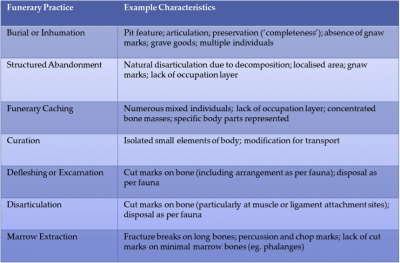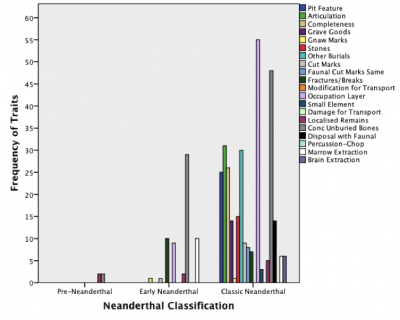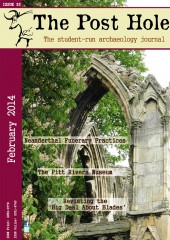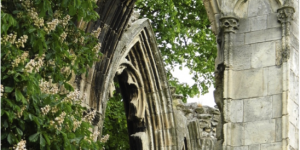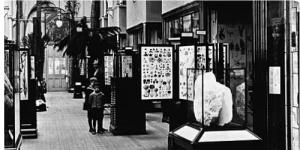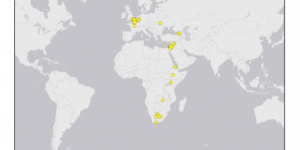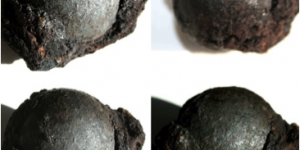Introduction
Death and dying are sensitive issues, but they are a natural and inevitable aspect of every culture around the world. The capability to understand the inevitability and conclusive nature of death, and the ability to honour and pay tribute to the dead through funerary practices are important cognitive steps forward. But to what extent are these features seen in the world of our closest relatives in the hominid family tree – Neanderthals? For example, they could hunt, work stone tools, and make clothes just as early Homo sapiens did, but did they really possess any of our ‘human’ affinities for mortuary practices? If Neanderthals did honour their dead, which funerary practices (if any) are evident in the archaeological record? If so, how variable are the practices in use, and are there any patterns in the data (for example, males subjected to one practice and females treated with another)? These are just a few of the questions I aimed to answer during my Masters dissertation, and I continue to explore in my PhD.
It all began, quite literally, with a ‘big bang’ as the remains of the first (recognised) Neanderthal were blasted out of the Neander Valley in August 1856. But the shockwave extended far beyond the reaches of the Neander Valley and the German borders, as the news of a new species of human being rocked the archaeological world. Some 150 years later we continue to debate every aspect of Neanderthal life and, of particular interest to this article, the intentions of the Neanderthals to dispose of the remains of their dead. The first remains challenged a number of preconceived ideas, such as Creationism, and presented the scholars of the late 19th century with some challenging questions (Trinkaus & Shipman 1993). How did the remains get here – were they accidental, or were they deliberately buried? And if so, how could these ‘primitive savages’ depicted in popular culture be capable of complex emotions?
Skeletal remains and recent research certainly suggest that Neanderthals were aware of their own mortality, and were capable of honouring their dead. Research by Aiello and Dunbar (1993) demonstrates they had a large cranial capacity, indicating they were capable of more complex cognitive processes than they are sometimes given credit for. Examinations of Neanderthal skeletal remains suggest they were aware of their own mortality and that of their peers, which can be found in elderly or infirm individuals found at various locations, such as individuals at Shanidar (Klein 2009; Trinkaus 1983). If an injury or condition was debilitating enough to require assistance from others in order to survive, the fact that these individuals have survived into late adulthood demonstrates that they were cared for by the rest of the group, who understood that without such attention the individual would die. It would also suggest that they were willing to provide such assistance, even knowing that the individual might not be able to contribute to the rest of the group, with the possibility of the group’s help being largely unreciprocated. One can therefore assume that this unreciprocated care could be extended to the deceased as well, and therefore focus remains on signs of funerary practices on specific sites, rather than on whether or not Neanderthals buried their dead.
Funerary Practises in Use
A funerary practice is an act utilising rites in order to remember and honour a deceased individual within the community, but there are a number of different funerary practices. The most familiar and widely used practices at present in the Western World are inhumation (or burial) and cremation, but there are many others used in cultures across the globe and throughout human history.
Table 1 lists just a few of the funerary practices examined in this project, and characteristics which could identify them in the archaeological record. It is by no means an exhaustive list, but provides an idea of the range and types of characteristics to look for. They cover most practices from the most basic of techniques, such as curation (carrying all of a small part of the deceased), to lengthy and involved techniques such as defleshing (removal of all the soft tissue from the bones) (Pettitt 2011). The more characteristics demonstrated on a particular site, the higher the chance that this specific funerary practice or technique was employed.
Although we discuss terms such as defleshing and disarticulation, use of the term ‘cannibalism’ is deliberately avoided as it is not yet possible to conclusively prove that the living were consuming the remains (this is to be addressed through further research) – and if so, exactly what the purpose of this act was. Instead, this project has focused on the primary actions of the group which has been recorded in the archaeological record, rather than assuming that this must mean that their final intention was cannibalism.
It is important to note that the funerary practices employed are statements of the beliefs and actions of the living, not of the dead. Although it is the corpse which we have as evidence, they can only demonstrate the thoughts of the living who ultimately decided which practice to use and actioned them. Therefore, we are attempting to unravel the intentions of the (then) living group, and not of the deceased, who would have had at best, limited input into their own funerary rites.
Methodology
In order to examine Neanderthal remains for evidence of a variety of funerary practices, a database of all known remains was compiled to include information such as: gender; age at death; ‘type’ of Neanderthal (see below); and a brief inventory of the remains. Data gathering began by using a collection of known sites as listed in a paper by Serangeli and Bolus (2008), which includes European Neanderthal sites, which was then augmented to include other non-European sites using a range of other published primary data. Information regarding age at death was gathered from a number of published sources per individual and, as in most cases, there was not enough of the individual remaining to produce a precise age, an age range was produced for each individual. They were then placed into an age category, based on categories as outlined in White and Folkens (2005).
In addition, each set of remains was categorised as either an “Early Neanderthal” or a “Classic Neanderthal” in order to examine changes over time, and potentially cognitive changes (Serangeli & Bolus 2008). An “Early Neanderthal” is defined as not yet displaying the full range of typical Neanderthal anatomical features, but is definitely a separate species from Homo heidelbergensis, which would include sites from ca. 200,000 – 115,000 years BP (for example, Bau de l’Aubsier, France and Krapina, Croatia). A “Classic Neanderthal” displays the full range of typical Neanderthal features, such as large brow ridges and a low cranial vault, and includes sites from the start of the last glacial at ca. 115,000 years BP and later (for example, La Chapelle-aux-Saints and La Quina, France). Although these definitions were initially applied to the list of European Neanderthals, for standardisation they were also applied to other non-European sites using information from other sources.
To examine changes in funerary practices due to geographical location within the Neanderthal world, each site was categorised into one of the following categories: Western Europe, Eastern Europe (the border between the two lying approximately between Germany, the Czech Republic, and Austria), and Asia. Although these are based on modern borders they were sufficient for the initial dissertation project, and random enough in terms of the Neanderthal world to have minimal impact on the study.
As discussed above, a set of characteristics of funerary practices was compiled, and each set of remains was examined for the presence or absence of those characteristics and recorded in the database. The final data set will then be analysed to identify the types of funerary practices that the presence of these characteristics suggest occurred.
Once all of the data was assembled, each site was assessed for suitability in the final data set. Sites or specific individuals were excluded for two reasons, due to time constraints and available resources: firstly, if sufficient information could not be obtained for specific individuals because the information was inaccessible; secondly, where dentition alone was excluded as it was not possible to conclude if they had been lost ante-mortem or post-mortem, and therefore whether they were part of any funerary actions. Deciduous teeth were most likely the result of natural loss as the juvenile matured, and fully adult teeth could have been lost due to decay. By following these two rules, approximately half of all known Neanderthal individuals from across the world were included in the final data set.
Results
The results of the initial research were generated using 197 Neanderthal individuals from the database (approximately half of the entire database) and included 38 “Early Neanderthals” and 142 “Classic Neanderthals”.
Results appeared to show that variability in funerary characteristics increases from the “Early” to the “Classic Neanderthals” (see figure 1), which suggests a greater variety of funerary practices are in use. “Early Neanderthals” appear to begin with characteristics such as defleshing and disarticulation implying corpse processing, and later “Classic Neanderthals” also introduced characteristics which are reminiscent of burial or internment, such as pit features. This suggests that as the species evolved into later “Classic Neanderthals”, they began to explore more options for funerary practices, eventually operating both corpse processing and burial at the same time.
The greatest variability by geographic location is in Western Europe, where most characteristics examined are accounted for. However, this could be due to a bias in the amount of data available for Western European sites (a point which will be addressed through continued research), and the number of individuals in this area.
This study also aimed to address whether factors such as gender or age at death had an impact upon the type of funerary practice an individual was subjected to upon their death. Initial research suggests that this is not the case, and no statistically significant pattern could be found for these factors. In addition, there appears to be no preference or strict use of particular funerary practices in particular geographical areas, and instead we find that the same types of characteristics (indicating the same funerary practices) are found across the Neanderthal world. Instead, the results thus far indicate that Neanderthals treat everyone in broadly the same way at the same time – for example, an elderly male Neanderthal in Western Europe is likely to be treated in the same way as a young female in Asia.
Conclusions
The conclusions thus far indicate that Neanderthals had no particular cultural or social patterns when it came to funerary practices – as already discussed, factors such as gender or geographical location were unlikely to influence what type of funerary practice an individual was subjected to upon their death. On the other hand, we also do not see a strict approach to funerary practices, where every burial or every corpse processing site appears the same in the archaeological record. What is apparent is that different characteristics and practices used increased over time, perhaps with the increase in cognitive ability allowing for more complex approaches. Although the concept of corpse processing may seem particularly alien to us, to Neanderthals it may have been viewed as a more natural first step to funerary practices than to us. As hunter-gatherers, they would have been more than capable of hunting, killing, and butchering an animal, and therefore applying these processing techniques to another hominid would not have been a large step to take.
With the arrival of the “Classic Neanderthals”, they begin using two different types of funerary practices: burial and corpse processing (defleshing and disarticulation). With no statistically significant pattern indicating why a particular practice would be chosen over another in each individual case, this may suggest a more ‘ad-hoc’ approach to funerary practices where Neanderthals lacked strict rules on the matter, instead adopting a more fluid and flexible approach.
It is important to remember that evidence of defleshing and disarticulation does not necessarily indicate evidence of cannibalism. In the past, scholars have immediately concluded that cut marks on bones means cannibalism and interpersonal violence, but this should be treated with caution. Although some remains demonstrate evidence of marrow extraction, which would almost certainly be intended for consumption, a large number show only cut marks and therefore we cannot be certain. In addition, we cannot assume the person has been killed specifically for the purpose of being consumed, and instead could have been consumed after their natural death. This distinction is a critical aspect of unravelling the intentions of the living group, and therefore their attitudes to death, and potential rituals employed.
Future Research
Further research throughout this PhD project will continue to explore the funerary practices used by Neanderthals through the augmented database produced in the preliminary stages of the project (with additions and updates). The categories of “Early” and “Classic Neanderthals” will be further divided into more specific time frames in order to examine in more detail the spread of funerary practices over the Neanderthal world, focusing on the European sites for which we have many reliably dated sites.
In addition, the sites will be mapped in order to examine the spatial relationship to each other, in order to determine whether there is any variability in terms of preferred locations and relationship to other Neanderthal sites (e.g. hunting sites) to examine the place of funerary sites within the Neanderthal landscape.
Further updates will be posted onto the author’s Academia page, which can be found at: https://soton.academia.edu/archaeosarah
Bibliography
- Aiello, L. & Dunbar, R. (1993) “Neocortex Size, Group Size, and the Evolution of Language”, Current Anthropology, 34(2): 184
- Defleur, A. ; White, T.; Valensi, P.; Slimak, L. and Crégut-Bonnourne, É. (1999) “Neanderthal Cannibalism at Moula-Guercy”, Science 286: 5437 pp 128 – 131
- Klein, R. (2009) The Human Career: Human Biological and Cultural Origins (3rd Edition), The University of Chicago Press: London, UK & Chicago, USA
- Larsen, C. (1997) Bioarchaeology: Interpreting behaviour from the skeleton, Cambridge University Press: Cambridge, UK
- Parker Pearson, M. (1999) “The Human Experience of Death” in M. Parker Pearson (ed), The Archaeology of Death and Burial (pp 142 – 156), Sutton Publishing Ltd: Stroud
- Pettitt, P. (2011) The Palaeolithic Origins of Human Burial, Taylor & Francis: London & New York
- Serangeli, J. and Bolus, M. (2008) “Out of Europe – The dispersal of a successful European hominin form”, Quartär 55 (2008): 83 - 98
- Trinkaus, E. (1983) The Shanidar Neanderthals, Academic Press: London, UK
- Trinkaus, E. & Shipman, P. (1993) The Neanderthals: The changing image of mankind, Jonathan Cape: London, UK
- White, T. & Folkens, P. (2005) The Human Bone Manual, Academic Press: London, UK
(Note: For a full list of references for the information held in the database, please contact the author directly.
This paper was based on a poster presented at the first ASA Conference in June 2013.)


